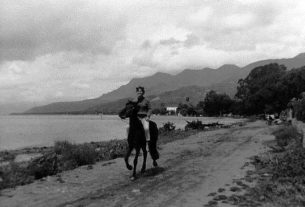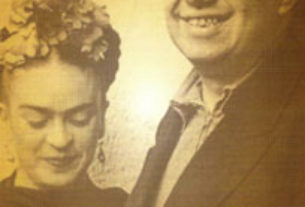Good Reading
Religion in Latin America: A Documentary History
By Lee M. Penyak and Walter J. Petry
Orbis Books, 2006
Available from Amazon Books: Paperback
Boring, I thought, when I first saw the title. Fascinating, I thought, after I had finished looking through it.
Religion in America is published by Orbis Books, which “endeavors to publish works that enlighten the mind, nourish the spirit, and challenge the conscience.” This book certainly does all three of those things.
When I initially flipped it open, I expected to find scholarly and therefore, to me, dry material. But instead I landed upon something immediately of interest to me: excerpts from the Memoirs of Pancho Villa. The editors offer this insight, “Despite an early career as a probable outlaw… he was an intelligent, thoughtful, and constructive political leader.”
Here is a passage in which Pancho Villa explains to a priest his own attitude toward Catholicism and religion:
“Remember, Sr. Priest, that our Revolution is the struggle of the poor against the rich, who thrive on the poverty of the poor. And if in this struggle we discover that the so-called priests of religion, or most of them, are on the side of the rich and not of the poor, what faith, Señor, can the people have in their advice? In my opinion, our justice involves such holiness that the priests and the churches who deny us their help have forfeited their claim to be men of God.”
When the owner of a large hacienda, Doña Luz, attempts to take Pancho Villa to task, saying to him, “You have committed many robberies, Sr. General Villa, and God says, ‘Thou shalt not steal,'” Villa replies:
“I have never stolen, Sra. Doña Luz. I have taken from those who had much in order to give to those who had little, or nothing. For myself, I have never taken anything belonging to another except in a situation of the most urgent necessity. And he who takes food when he is hungry does not steal, Sra. Doña Luz. He only complies with his duty to sustain himself. It is the rich who steal because, having everything they need, they still deprive the poor of their miserable bread.”
The themes in these powerful passages are echoed throughout Religion in Latin America. In the Preface, editors Penyak and Petry write that “we chose sources that force readers to grapple with the realities of imperialism, racism, poverty, and injustice, via eyewitness accounts of the dynamic religious currents in Latin American history. Rather than write extended texts “that render the documents almost superfluous, we chose to write contextual introductions that place documents in historical perspective and force students to think and analyze on their own.”
These original documents include accounts from when the Spanish first set foot on Latin America soil up to the present. The following passage, a letter from Christopher Columbus to Ferdinand and Isabella, King and Queen of Spain in the late 1400s, is one of the earliest included, a document, the editors acknowledge, is “permeated with fervent religious rhetoric.”
“Your Highnesses, as good Christian and Catholic princes, devout and propagators of the Christian faith, as well as enemies of the sect of Mahomet [Islam] and of all idolatries and heresies, conceived the plan of sending me, Christopher Columbus, to this country of the Indies, there to see the princes, the peoples, the territory, their disposition and all things else, and the way in which one might proceed to convert these regions to our holy faith.
“And Your Highnesses have ordered that I should go, not by land, towards the East, which is the accustomed route, but by way of the West, whereby hitherto nobody to our knowledge has ever been. And so, after having expelled all the Jews from all your kingdoms and lordships, in this same month of January, Your Highnesses ordered me to set out, with a sufficient fleet, for the said country of India, and to this end, your Highnesses have shown me great favour….”
A few decades after Columbus, Diego de Landa, a Franciscan zealot, in 1549 arrived in Yucatan, only seven years after the conquest of that province. The editors note that consequently Landa “would have been able to observe firsthand many of their traditional practices.” Here is a passage, in rather graphic prose, from Landa’s book, Yucatan before and after the conquest, which illustrates the fascination many of the Spaniards had for human sacrifice, in this case part of the Mayan religious practices:
“If his heart was to be taken out, they conducted him with great display and concourse of people, painted blue and wearing his miter, and placed him on the rounded sacrificial stone, after the priest and his officers had anointed the stone with blue and purified the temple to drive away the evil spirits. The chacs then seized the poor victim and swiftly laid him on his back across the stone, and the four took hold of his arms and legs, spreading them out. Then the… executioner came, with a flint knife in his hand, and with great skill made an incision between the ribs on the left side, below the nipple; then he plunged in his hand and like a ravenous tiger tore out the living heart, which he laid on a plate and gave to the priest; he then quickly went and anointed the faces of the idols with that fresh blood.”
Some of the earlier Spanish missionaries were appalled, likewise, by the sacrifice of millions of indigenous people to the European Gods. Penyak and Petry write that “Militant Catholic Spaniards began imposing their religion in the Americas at the moment of occupation, 1492.” Among those missionaries highly sensitive to the wanton destruction of the natives was Bertolomé de Las Casas, who in his History of the Indies writes, 49 years after the Spaniards had arrived:
“Among these gentle sheep… the Spaniards entered… like wolves, tigers, and lions which had been starving for many days, and since forty years they have done nothing else; nor do they otherwise at the present day, than outrage, slay, afflict, torment, and destroy them…. To such extremes has this gone that, whereas there were more than 3 million souls, whom we saw in Hispaniola, there are today not 200 of the native population left.”
Bertolomé de Casas, ardent defender of the natives, writes about the sacrifice of the Indian prince Hatuey to the Gods of the Spaniards, although the Spanish called such sacrifices executions:
“When he was tied to the stake, a Franciscan friar, a holy man who was there, spoke as much as he could to him, in the little time that the executioner granted them, about God and some of the teachings of our faith…. He told him that if he would believe what was told him, he would go to heaven where there was a glory and eternal rest; and if not, that he would go to hell, to suffer perpetual torments and punishment.
“After thinking a little, Hatuey asked the friar whether the Christians went to heaven; the friar answered that those who were good went there. The prince at once said, without any more thought, that he did not wish to go there, but rather to hell so as not to be where Spaniards were, nor to see such cruel people.
“This is the renown and honor that God and our faith have acquired by means of the Christians who have gone to the Indies….”
The original documents are organized into 22 different chapters. Some of the titles are:
- Indigenous Religions
- Encounter, Conquest, Empire
- Conversion”
- Roman Catholicism Triumphant?
- The Church and Slavery
- The Holy Office of the Inquisition
- Enter Protestantism
- Latin Jews, Afro-Latinos, and Amerindians
- The Troubled Twentieth Century
Note that although Catholicism is still the dominant religion in Latin America (although in steady decline as documented in Religion in Latin America), Penyak and Petry include all religions that are established in Latin America. For example, there is a piece by Shep Lenchek, “Jews in Mexico, A Struggle for Survival,” which — incidentally — was first published in Mexico Connect (May 2000). Lenchek proclaims that:
“Jews have much in common with their fellow Mexicans. Both groups are sincerely religious and family oriented. Both were victims of oppression and have suffered tyranny. Even in modern times, they have felt discrimination, Mexicans in the United States, Jews in Russia. Descendants of survivors, bolstered by strong religious convictions, they are determined to survive. Ultimately, like all those who live in Mexico, their future depends largely on the ability of their homeland to make social and economic progress.”
Just as sensitive Catholic missionaries in centuries that immediately followed the conquest were horrified at the casual extermination of the native populations and the exploitation and even enslavement of those remaining, and attempted to address basic issues of human rights, sensitive Catholics (and Protestants) in the 20th and 21st century also address the role of church organizations and the social issues of poverty, of enormous disparity between the rich and the poor.
Camilo Torres was ordained a Catholic priest in 1954, in Colombia, but he left the church in 1965 to join the Army of National Liberation (a Marxist organization) and was killed in his first military engagement. He writes:
- I took of my cassock to be more truly a priest.
- The duty of every Catholic is to be a revolutionary.
- The duty of every revolutionary is to make the revolution.
- The Catholic who is not a revolutionary is living in mortal sin.
Fidel Castro of Cuba, perhaps the most famous revolutionary leader in Latin American history, in this 1980 speech celebrates that:
“Many religious leaders have stopped talking exclusively about reward in the other world and happiness in the other world and are talking about the needs of this world and happiness in this world. For they see the hunger of the people, the poverty, the unhealthy conditions, the ignorance, suffering, and pain.”
In that same speech Fidel Castro urges us to:
“Look how reaction and fascism are constantly murdering priests, how the archbishop of el Salvador was brutally assassinated. This is because reactionaries and fascists – many of whom go to church every Sunday – when they see their interests affected, endangered, do not hesitate to plant bombs in churches and to assassinate priests and bishops.”
Indeed the book, Religion in America, is dedicated to a beloved bishop:
The book is dedicated to the memory of
Oscar Arnulfo Romero (1917-1980),
archbishop of San Salvador
and strident defender of human rights,
a true shepherd to his flock,
assassinated by members of El Salvador’s
military establishment while celebrating Mass.
Like David W. Dent’s book, Encyclopedia of Modern Mexico, which I reviewed in a recent issue of Mexico Connect, this book – Religion in Latin America — is one of those books you can leave on your coffee table to pick up for a few rewarding moments of fascinating history or you can carry it in your Mexican book bag to read while waiting in line at the bank or while sipping your mocha in a sidewalk café. It is also a book that can change the way you think about Mexican and Latin American history, or at least deepen the sense you already have of important social issues that remain with us today.


